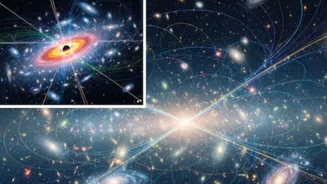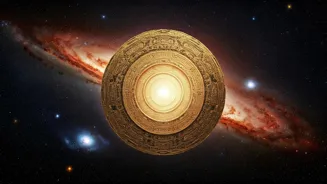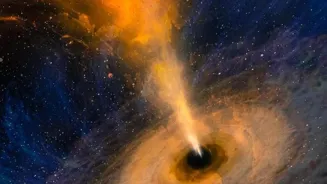Exploring the Universe's Mind-Bending Mysteries: 10 mind-blowing facts that reveal the universe's mind-boggling secrets. Dive in!
Namaste, readers! Buckle up your seatbelts, because today we're taking a wild
ride through the cosmos. Forget your everyday worries about traffic jams and electricity bills, because the universe is far weirder than anything you can see on your television.
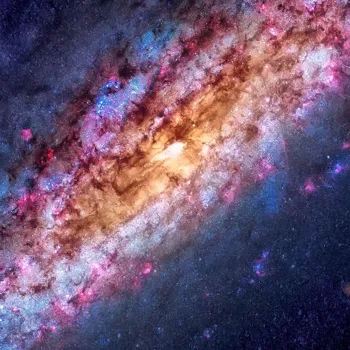
Prepare to have your mind blown, because we're diving into 10 things that show just how strange and amazing the universe truly is, absolutely mind-blowing stuff, you know!
Dark Matter and Dark Energy: The Invisible Big Bosses
Okay, imagine you're trying to balance your budget at home, but you can only see where half of your money is going. That's kinda like what scientists are facing with the universe. We can only see about 5% of the entire universe – the stars, planets, galaxies, all the shiny stuff. The rest?
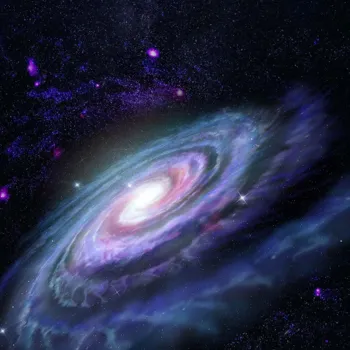
That's dark matter and dark energy and it is not light to visible through telescopy.
Dark matter is like an invisible glue that holds galaxies together. Without it, they'd spin apart like a ceiling fan that's gone crazy.
We can't see it, but we know it's there from its gravitational pull, like feeling a ghost sitting next to you. Dark energy is even more mysterious. It's like an invisible force continuously pushing the universe apart, causing it to expand faster and faster.
Scientists haven't got a clue what dark energy is, but it makes up about 68% of the universe. Matlab (meaning), we only understand a tiny fraction of the cosmos! Dark matter and dark energy, both play very vital roles in shaping up the universe. Isn't this something to ponder?
Quantum Entanglement: Spooky Action at a Distance
Picture this: you have two coins. You put one in Mumbai and send the other to Bengaluru. Before you look at them, they are both spinning. The moment you look at the coin in Mumbai and see it's heads, you instantly know that the coin in Bengaluru is tails. That's quantum entanglement in a nutshell.
Now listen, it is strange!
Except, instead of coins, we're talking about tiny particles. And instead of Mumbai and Bengaluru, we're talking about distances of possibly millions of light-years.
When two particles are entangled, they are linked in such a way that the state of one instantly affects the state of the other, no matter how far apart they are. Einstein called it "spooky action at a distance." It's as if they're communicating faster than the speed of light, which is not possible.
Entanglement is complex but it's real. This could revolutionize computing and communication in the future, bringing mind-blowing tech.
The Multiverse: Are We Just One Bubble?
What if our universe is just one bubble in a giant bathtub filled with other bubbles, each one a different universe with its own laws of physics? The Multiverse theory says that our universe may not be the only one.
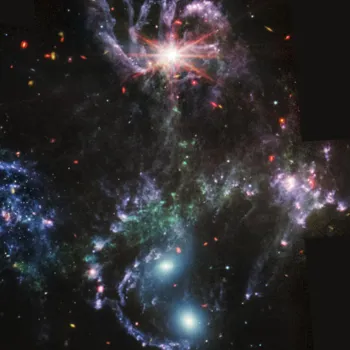
There could be an infinite number of universes out there, each with its own set of rules and possibilities.
In some universes, gravity might be stronger, or the speed of light might be slower. There could even be universes where time runs backward, or where the laws of thermodynamics don't apply!
It's a crazy thought, but some scientists believe that the Multiverse is the best explanation for some of the weirdness we observe in our own universe. Imagine a universe where your neighbours are all aliens, or where it always rains yummy gulab jamuns!
The possibilities are endless and quite funny actually.
Time Dilation: Time Is Relative, Yaar!
Time, that relentless clock ticking away our lives, isn't as constant as we think. Einstein taught us that time is relative. It depends on how fast you're moving relative to someone else. This is called time dilation.

If you were to hop on a spaceship and travel close to the speed of light, time would slow down for you relative to someone on Earth.
When you came back, you would have aged less than the person who stayed behind.
This isn't just a theory; it's been proven with experiments involving atomic clocks on airplanes. The faster you move, the slower time ticks thus slowing down the rate of ageing. So those astronauts who spend a lot of time in space? They technically live a little bit longer than us Earthlings.
Who would've thought right?
Cosmic Microwave Background Radiation: Echo of the Big Bang
The Cosmic Microwave Background Radiation (CMB) is like the afterglow of the Big Bang, the event that birthed the universe about 13.8 billion years ago. It's faint radiation that permeates the entire universe and can be detected by special telescopes.
Studying the CMB is like reading the baby pictures of the universe.
It gives us clues about the universe's early conditions, density, and composition. The CMB isn't perfectly uniform but has tiny temperature fluctuations. It acts as a window to look into the very early universe.
These become the seeds that grew into galaxies and all the structures we see now. It's amazing to think that we can still see the faint echo of the universe's birth.
Exoplanets: Worlds Beyond Our Backyard
For a long time, we only knew about the planets in our own solar system. Now, thanks to advanced telescopes like Kepler, we've discovered thousands of exoplanets orbiting other stars. Some of them are super-Earths, rocky planets much bigger than our own.
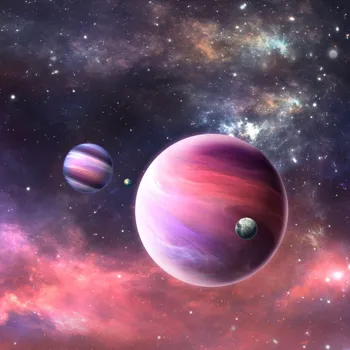
Some are hot Jupiters, gas giants that orbit incredibly close to their stars.
Some might even be Earth-like planets in the habitable zone of their star, where liquid water can exist on the surface.
The discovery of exoplanets has revolutionized our understanding of planetary systems and greatly increased the chances of finding life beyond Earth. It also shows us that there are a bunch of different planetary systems out there. Who knows what other surprises the universe has in store for us?
The universe is full of secrets. Every new discovery brings up even more questions. So, keep looking up, keep pondering, and keep wondering! The universe is a vast and mysterious place that is always expanding our understanding in many ways.







